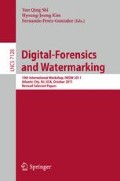Abstract
This paper presents an efficient JPEG steganography method based on improved matrix encoding. Compared to the original matrix encoding (ME), the proposed improved matrix encoding uses two intersected ME blocks of the DCT coefficients as a single combined block. We propose a way to get a join solution of the two intersected ME, such that the intersected area does not affect the result. Due to intersection the improved matrix encoding may use a matrix encoding scheme with higher embedding rate. In order to survive steganalysis we hides data to DCT coefficients which cause the lowest distortion after modification. We used the original bitmap image for computing the distortion and getting the modified JPEG image. The proposed insert-remove strategy modifies the input stream of the DCT coefficients by inserting or removing coefficients 1 or -1. Any insertion and removing results the different solutions for the improved matrix encoding. Among all possible solutions the proposed method chooses solution with the lowest distortion. Such method significantly increases the number of possible solutions and, as a result, decreases the total distortion after data hiding. The experiments include the steganalysis of the proposed improved matrix encoding with and without using the insert-remove strategy. The experiment results shows that the proposed methods has lower detectability of the steganalysis compared to the existing steganographic methods.
Access this chapter
Tax calculation will be finalised at checkout
Purchases are for personal use only
Preview
Unable to display preview. Download preview PDF.
References
Upham, D.: http://www.funet.fi/pub/crypt/stegangraphy/jpeg-jsteg-v4.diff.gz
Eggers, J., Bauml, R., Girod, B.: A communications approach to steganography. In: Proc. of EI SPIE, San Jose, CA, vol. 4675, pp. 26–37 (2002)
Chien, R.T.: Cyclic decoding produce for the Bose-Chaudhuri-Hocquenghem codes. IEEE Transactions on Information Theory 11, 549–557 (1965)
Fridrich, J.: Minimizing the embedding impact in steganography. In: Proc. of ACM Multimedia and Security Workshop, Geneva, Switzerland, September 26-27, pp. 2–10 (2006)
Fridrich, J.: Feature-Based Steganalysis for JPEG Images and Its Implications for Future Design of Steganographic Schemes. In: Fridrich, J. (ed.) IH 2004. LNCS, vol. 3200, pp. 67–81. Springer, Heidelberg (2004)
Fridrich, J., Filler, T.: Practical methods for minimizing embedding impact in steganography. In: Proc. EI SPIE, San Jose, CA, vol. 6505, pp. 2–3 (2007)
Fridrich, J., Goljan, M., Soukal, D.: Perturbed quantization steganography using wet paper codes. In: Proc. of ACM Workshop on Multimedia and Security, Magdeburg, Germany, September 20-21, pp. 4–15 (2004)
Fridrich, J., Pevny, T., Kodovsky, J.: Statistically undetectable JPEG steganography: dead ends, challenges, and opportunities. In: Proc. of ACM Workshop on Multimedia and Security, Dallas, Texas, September 20-21, pp. 3–15 (2007)
Fridrich, J., Goljan, M., Soukal, D.: Perturbet quantization steganography. ACM Multimedia and Security Journal 11(2), 98–107 (2005)
Fridrich, J., Goljan, M., Soukal, D.: Wet paper coding with improved embedding efficiency. IEEE Transactions on Information Security and Forensics 1(1), 102–110 (2005)
Kim, Y.H., Duric, Z., Richards, D.: Modified Matrix Encoding Technique for Minimal Distortion Steganography. In: Camenisch, J.L., Collberg, C.S., Johnson, N.F., Sallee, P. (eds.) IH 2006. LNCS, vol. 4437, pp. 314–327. Springer, Heidelberg (2007)
Noda, H., Niimi, M., Kawaguchi, E.: Application of QIM with dead zone for histogram preserving JPEG steeganography. In: Proc. of ICIP, Genova, Italy (2005)
Pevny, T., Fridrich, J.: Multiclass blind steganalysis for JPEG images. In: Proc. of SPIE, San Jose, CA, January 16-19, vol. 6072, pp. 257–269 (2006)
Pevny, T., Fridrich, J.: Merging Markov and DCT features for multi-class JPEG steganalysis. In: Proc. of SPIE, San Jose, CA, vol. 6505, pp. 3–4 (2007)
Provos, N.: Defending against statistical steganalysis. In: Proc. of 10th USENIX Security Symposium, pp. 24–24 (2001)
Sachnev, V., Kim, H.J., Zhang, R., Choi, Y.S.: A novel approach for JPEG steganography. In: Proc. of 7nd International Workshop on Digital Watermarking 2008, Busan, Korea, November 10-12, pp. 216–226 (2008)
Sachnev, V., Kim, H.J., Zhang, R.: Less detectable JPEG steganography method based on heuristic optimization and BCH syndrome coding. In: Proc. of ACM Workshop on Multimedia and Security, Princeton, NJ, September 7 - 8, pp. 131–139 (2009)
Sallee, P.: Model-Based Steganography. In: Kalker, T., Cox, I., Ro, Y.M. (eds.) IWDW 2003. LNCS, vol. 2939, pp. 154–167. Springer, Heidelberg (2004)
Schnfeld, D., Winkler, A.: Embedding with syndrome coding based on BCH codes. In: Proc. of ACM Workshop on Multimedia and Security, pp. 214–223 (2006)
Schönfeld, D., Winkler, A.: Reducing the Complexity of Syndrome Coding for Embedding. In: Furon, T., Cayre, F., Doërr, G., Bas, P. (eds.) IH 2007. LNCS, vol. 4567, pp. 145–158. Springer, Heidelberg (2008)
Solanki, K., Sarkar, A., Manjunath, B.S.: YASS: Yet Another Steganographic Scheme That Resists Blind Steganalysis. In: Furon, T., Cayre, F., Doërr, G., Bas, P. (eds.) IH 2007. LNCS, vol. 4567, pp. 16–31. Springer, Heidelberg (2008)
Westfeld, A.: F5-A Steganographic Algorithm High Capacity Despite Better Steganalysis. In: Moskowitz, I.S. (ed.) IH 2001. LNCS, vol. 2137, pp. 289–302. Springer, Heidelberg (2001)
Zhao, Z., Wu, F., Yu, S., Zhou, J.: A lookup table based fast algorithm for finding roots of quadratic or cubic polynomials in the GF(2m). Journal of Huazhong University of Science and Technology (Nature Science Edition) 33(1) (2005)
Zhang, R., Sachnev, V., Kim, H.J.: Fast BCH Syndrome Coding for Steganography. In: Katzenbeisser, S., Sadeghi, A.-R. (eds.) IH 2009. LNCS, vol. 5806, pp. 48–58. Springer, Heidelberg (2009)
Author information
Authors and Affiliations
Editor information
Editors and Affiliations
Rights and permissions
Copyright information
© 2012 Springer-Verlag Berlin Heidelberg
About this paper
Cite this paper
Sachnev, V., Kim, H.J. (2012). An Improved Matrix Encoding Scheme for JPEG Steganography. In: Shi, Y.Q., Kim, HJ., Perez-Gonzalez, F. (eds) Digital Forensics and Watermarking. IWDW 2011. Lecture Notes in Computer Science, vol 7128. Springer, Berlin, Heidelberg. https://doi.org/10.1007/978-3-642-32205-1_3
Download citation
DOI: https://doi.org/10.1007/978-3-642-32205-1_3
Publisher Name: Springer, Berlin, Heidelberg
Print ISBN: 978-3-642-32204-4
Online ISBN: 978-3-642-32205-1
eBook Packages: Computer ScienceComputer Science (R0)

